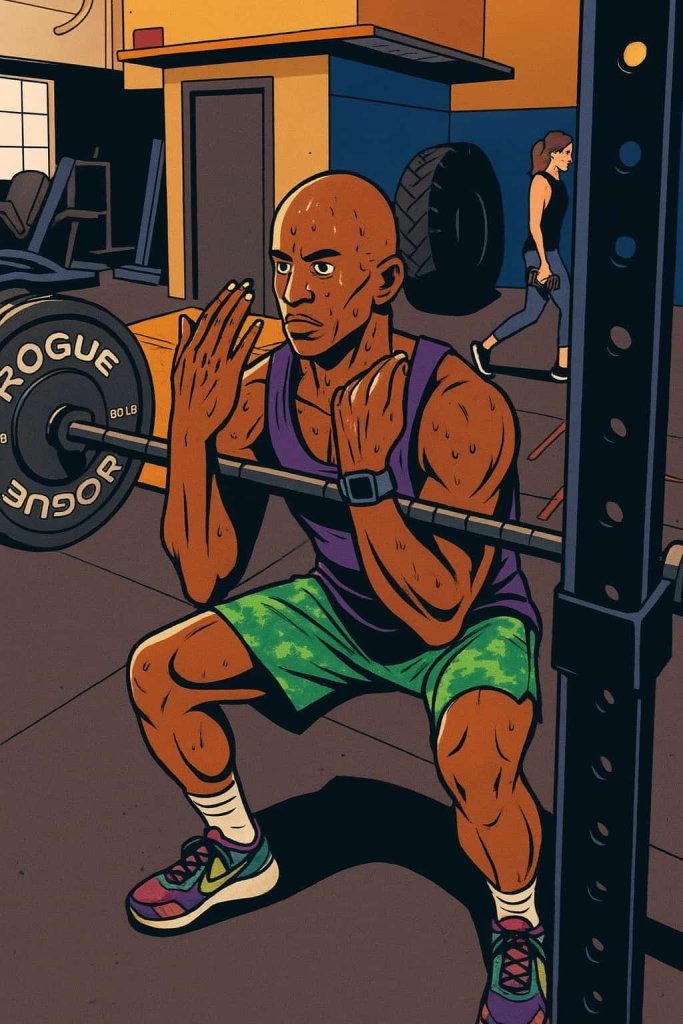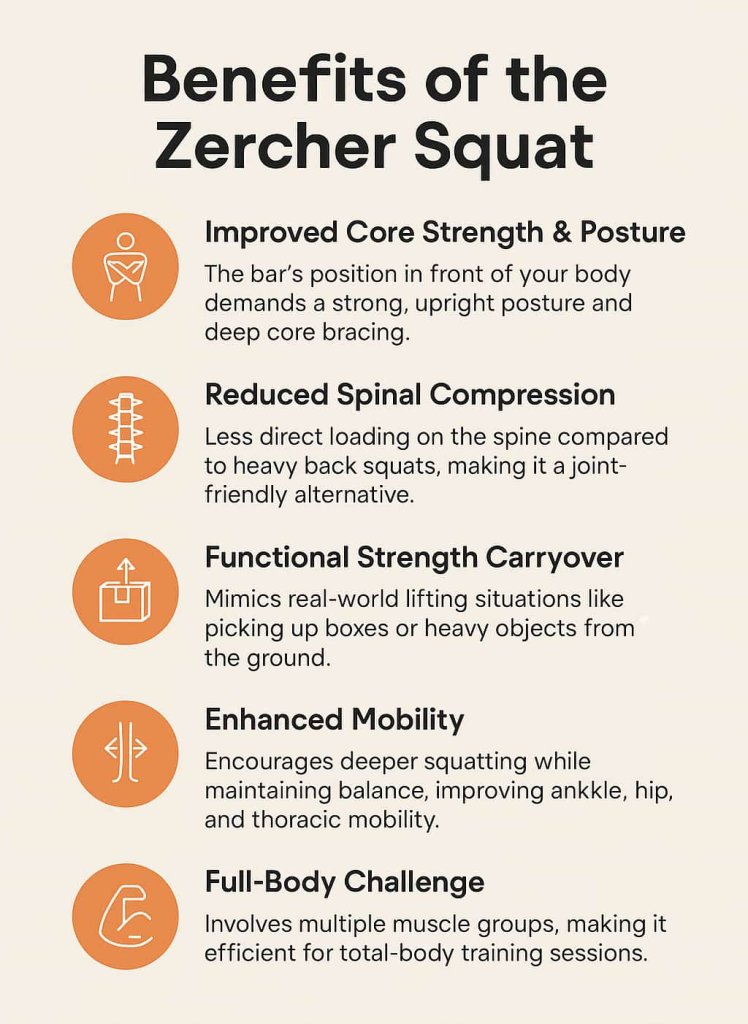The Zercher squat is a front-loaded squat variation where the barbell is held in the crook of your elbows instead of on your back.
This position keeps your torso upright, forces your core to work harder, and places less direct compression on the spine. It’s a highly functional lift with real-world carryover, especially for athletes, strongman competitors, and lifters seeking variety.

By learning proper form, avoiding common mistakes, and tailoring variations to your goals, you can turn the Zercher squat into a powerful tool for building strength, stability, and muscle.
Proper Form: Step-by-Step Execution
The Zercher squat may feel awkward at first due to the bar position, but mastering the steps ensures safety and effectiveness.
1. Setup
- Place a barbell on a squat rack at or slightly below belly-button height.
- Stand close, hook your arms under the bar, and cradle it in the bend of your elbows.
- Keep forearms vertical and elbows tight to your body. If needed, wrap the bar with a towel or use a squat pad for comfort.
2. Unrack
- Stand tall to lift the bar out of the rack.
- Take 1–2 small steps back.
- Set your stance: feet shoulder-width apart, toes slightly turned out.
3. Bracing
- Take a deep breath into your diaphragm.
- Engage your core and squeeze your upper back.
- Keep your eyes fixed on a point ahead of you.
4. Descent
- Push hips back slightly while bending your knees.
- Keep elbows lifted and bar close to your torso.
- Descend until elbows pass inside your knees or lightly touch your thighs.
- Maintain a tall chest and neutral spine.
5. Ascent
- Drive through your heels.
- Push your chest upward as you stand tall.
- Fully extend hips at the top while keeping the bar stable.
Trainer Insight: If you feel your torso collapsing forward, reduce weight and refocus on bracing before increasing the load.
Muscles Worked
Primary Muscles:
- Quadriceps – Primary drivers for knee extension.
- Gluteus maximus – Extends hips during ascent.
- Hamstrings – Stabilize and assist in hip extension.
- Core (rectus abdominis, obliques, transverse abdominis) – Maintain stability.
Secondary Muscles:
- Upper back (trapezius, rhomboids, rear deltoids) – Keep the torso upright.
- Biceps & forearms – Isometric hold of the barbell.
- Adductors – Stabilize legs in the bottom position.
Science Insight: An EMG study (American Council on Exercise, 2021) found that front-loaded squat variations, including the Zercher squat, activate the core muscles significantly more than back squats due to the increased forward center of gravity.
Benefits of the Zercher Squat

- Improved Core Strength & Posture
The bar’s position in front of your body demands a strong, upright posture and deep core bracing. - Reduced Spinal Compression
Less direct loading on the spine compared to heavy back squats, making it a joint-friendly alternative. - Functional Strength Carryover
Mimics real-world lifting situations like picking up boxes or heavy objects from the ground. - Enhanced Mobility
Encourages deeper squatting while maintaining balance, improving ankle, hip, and thoracic mobility. - Full-Body Challenge
Involves multiple muscle groups, making it efficient for total-body training sessions.
Variations for Different Goals
1. Heavy Zercher Squat (Max Strength)
How to:
- Use standard Zercher setup with heavy load at 3–5 reps.
- Focus on explosive drive out of the hole.
Why it Works: Builds raw lower body and core strength while improving bracing under load.
Trainer Tip: Use lifting straps looped around the bar to reduce forearm strain on heavy attempts.
2. Zercher Anderson Squat (Explosive Starting Strength)
How to:
- Set the bar on safety pins at your bottom squat position.
- Start each rep from a dead stop without any bounce.
Why it Works: Eliminates stretch reflex, forcing pure concentric strength development.
Trainer Tip: Keep core tight before initiating lift—there’s no momentum to help you.
3. Cyclist Zercher Squat (Quad Hypertrophy)
How to:
- Elevate heels on wedge or plates.
- Perform Zercher squats with deep knee bend and upright torso.
Why it Works: Increases knee flexion, shifting focus to quadriceps growth.
Trainer Tip: Use moderate loads and controlled tempo for maximum quad tension.
4. Zercher Carry (Core & Posture)
How to:
- Hold bar in crook of elbows and walk set distance.
- Keep shoulders back, chest tall, and steps short.
Why it Works: Trains anti-flexion core strength and reinforces upright posture under load.
Trainer Tip: Focus on smooth, controlled breathing to maintain bracing.
5. Zercher Split Squat (Balance & Stability)
How to:
- Take split stance with one foot forward, one back.
- Perform Zercher squats one leg at a time.
Why it Works: Corrects imbalances, enhances coordination, and improves hip stability.
Trainer Tip: Start with lighter loads until balance is mastered.
Common Mistakes to Avoid
- Forward Leaning – Keep chest up and elbows tight; this is often caused by too much weight.
- Elbows Dropping – Actively lift elbows to keep the bar close to your body.
- Poor Bracing – Inhale deeply and expand your core before every rep.
- Wide or Narrow Stance Errors – Adjust to shoulder-width with slight toe flare for optimal depth.
- Rushing Reps – Control the descent to improve time under tension.
Alternatives
- Front Squat – Similar upright posture without elbow discomfort.
- Goblet Squat – Beginner-friendly front-loaded variation.
- Safety Bar Squat – Comfortable front-load position for those with shoulder issues.
- Hack Squat Machine – Quad-dominant with minimal upper body demand.
Who Should Do the Zercher Squat
- Strongman athletes for loaded carry events.
- Combat sports athletes needing functional core strength.
- Lifters with shoulder mobility restrictions.
- Anyone seeking improved posture and real-world lifting capability.
- Athletes needing deep squat strength in an upright position.
Trainer Tips for Success
- Always warm up with mobility drills before loading heavy.
- Use a pad or towel to prevent elbow bruising.
- Keep bar path vertical for optimal force transfer.
- Pair Zerchers with posterior chain exercises for balanced development.
- Film your lifts to check torso angle and elbow position.
Programming Examples
Strength:
- 3–5 sets × 3–5 reps, 2–3 minutes rest.
Hypertrophy:
- 3–4 sets × 6–10 reps, 90–120 seconds rest.
Conditioning/Core:
- 3–5 rounds: 8 Zercher squats + 20–30m Zercher carry.
FAQs
1. Is the Zercher squat safe for beginners?
Yes, if you start light and learn correct bracing.
2. How heavy should I go?
Start at 40–50% of your back squat weight.
3. Do I need a bar pad?
Not mandatory, but it helps with comfort.
4. Is it better than front squats?
They serve different purposes; Zerchers excel at core engagement.
5. Can I do them without a rack?
Yes, but you must deadlift the bar into position—requires good form.
6. Will it hurt my elbows?
Discomfort is normal at first; padding and gradual loading help.
7. Can I use it for sports performance?
Absolutely—great for wrestlers, MMA fighters, and athletes needing functional strength.
Conclusion
The Zercher squat is more than just a squat variation — it’s a full-body strength builder, a posture corrector, and a core killer. Whether you’re training for maximum strength, hypertrophy, mobility, or functional fitness, there’s a Zercher variation for your goal. Start light, focus on form, and progress steadily to unlock its full potential.
